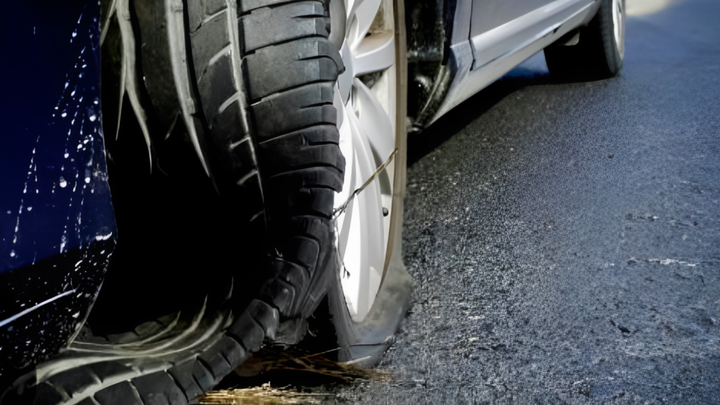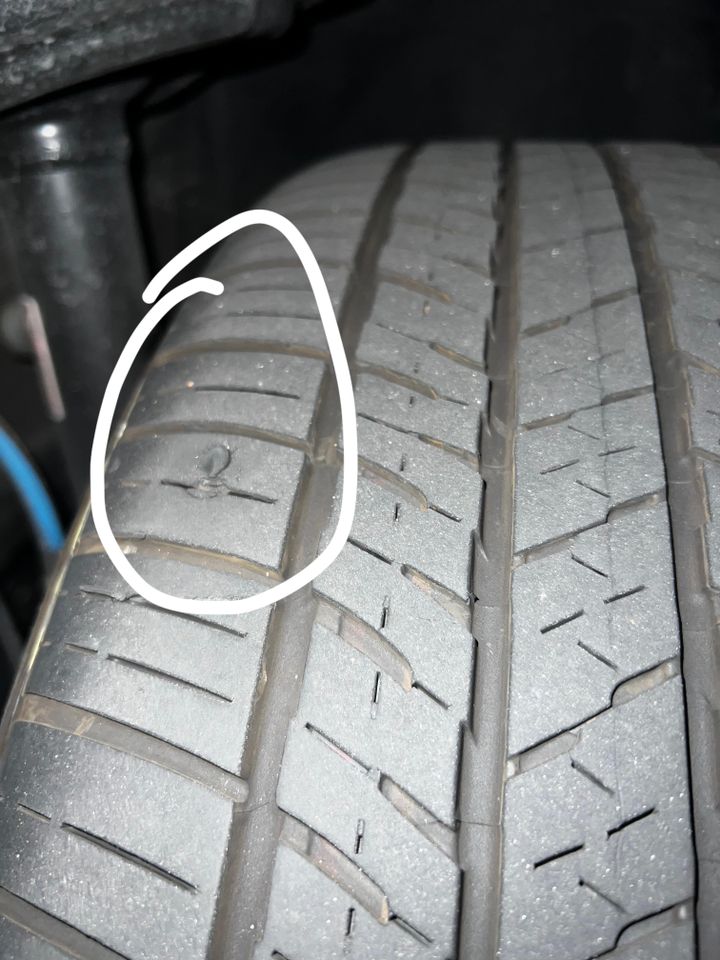


Proper tire maintenance is crucial for ensuring vehicle safety, optimal performance, and maximizing the lifespan of your tires. Neglecting tire care can lead to various issues, including decreased fuel efficiency, reduced handling and braking capabilities, and an increased risk of accidents.

Before we dive into the specifics, let's first understand what a tire belt is and why it's so crucial. Tire belts are steel or fabric reinforcements that run radially across the tire's tread area, providing structural integrity and resistance against the immense forces generated during driving.
When these belts break or separate from the tread, it can cause a bulge or bubble on the tire's surface, compromising its performance and safety. Here's a table illustrating the common causes of tire belt failure:
| Cause | Description |
|---|---|
| Impact Damage | Hitting potholes, curbs, or road debris can inflict severe damage to the tire belts, causing them to break or separate from the tread. Even a single impact can be enough to compromise the belt's integrity. |
| Manufacturing Defects | In some cases, faulty steel belts or improper tire construction during manufacturing can lead to premature belt failure. This could be due to quality control issues, material defects, or improper assembly processes. |
| Excessive Wear and Tear | Underinflation, overloading the tires, or misaligned wheels can accelerate tire wear and increase stress on the belts, causing them to break down faster. Improper maintenance and usage can significantly reduce the lifespan of tire belts. |
It's important to note that tire belt failure can occur suddenly or gradually, depending on the underlying cause and the severity of the damage or wear.
As a mechanic, I always emphasize the importance of regular tire inspections to catch any potential issues early on. Here are some telltale signs that a tire belt may be broken:
Visual Inspection
Look for bulges, bubbles, or uneven tread wear patterns, which can indicate belt damage.
Inspect the tire's sidewalls for any cracks, cuts, or other signs of impact damage that may have affected the belts internally.
Tactile Inspection
Run your hand along the tread to feel for any lumps or irregularities that could signify a broken belt.
Pay close attention to any unusual vibrations or handling issues while driving, as these can also be indicators of belt damage.
If you notice any of these signs, it's crucial to have the tire inspected by a professional as soon as possible. Ignoring the problem can lead to more severe consequences down the road.
While it may be tempting to continue driving on a tire with a broken belt, especially if you're in a hurry or far from a repair shop, doing so can be extremely dangerous. Here are some of the potential risks:
| Risk | Description |
|---|---|
| Blowout | A broken tire belt can cause the tire to separate from the wheel, leading to a sudden and catastrophic blowout, which can result in a loss of control and a serious accident. |
| Handling and Stability Issues | A tire with a broken belt may exhibit poor handling characteristics, such as vibrations, pulling to one side, or reduced traction, making it difficult to control the vehicle. |
| Increased Wear and Damage | Driving on a damaged tire can cause further wear and damage to other components, such as the suspension, brakes, and wheel bearings, leading to additional repair costs. |
| Safety Hazard | A tire failure at high speeds can be life-threatening, not only for you but also for other drivers on the road. The risk of a severe accident increases significantly when driving on a compromised tire. |
It's essential to understand that these risks are not just theoretical – they are real and can have devastating consequences. As a mechanic, I've seen firsthand the aftermath of accidents caused by tire failures, and it's a scenario that no driver should ever have to experience.
The short answer is: not very long. As a general rule, I advise against driving any significant distance on a tire with a broken belt. The risks simply outweigh the potential convenience of trying to reach your destination.
However, in an emergency situation where you have no immediate access to a repair facility or spare tire, you may need to drive a short distance to reach a safe location. In such cases, here are some guidelines:
Reduce Speed: Immediately reduce your speed to a maximum of 30-40 mph (48-64 km/h) to minimize the stress on the damaged tire.
Avoid Sudden Maneuvers: Steer and brake gently, as sudden movements can cause further damage or a blowout.
Distance Limit: Aim to drive no more than 5-10 miles (8-16 km) on the damaged tire, or until you reach a safe location where you can change the tire or seek professional assistance.
Monitor the Tire: Regularly check the condition of the damaged tire and be prepared to pull over if it shows signs of further deterioration or a potential blowout.
It's important to note that these guidelines are for emergency situations only and should not be considered a long-term solution. Driving on a broken tire belt is inherently unsafe and can lead to serious consequences, even if you follow these precautions.
If you've identified a broken tire belt, the only safe and recommended course of action is to replace the damaged tire. Unfortunately, tire belts cannot be repaired or patched, as the structural integrity of the tire has been compromised.
When replacing a tire due to a broken belt, it's generally advisable to replace both tires on the same axle (front or rear) to maintain proper handling and traction. In some cases, mechanics may recommend replacing all four tires, especially if the remaining tires are nearing the end of their service life.
The cost of replacing a tire can vary significantly depending on the vehicle make and model, as well as the brand and quality of the replacement tire. Here's a table with approximate cost ranges for different tire types:
| Tire Type | Average Cost per Tire |
|---|---|
| Economy/Budget | $50 - $150 |
| Mid-Range | $100 - $300 |
| Premium/High-Performance | $200 - $500+ |
| Light Truck/SUV | $150 - $400+ |
Keep in mind that these are rough estimates, and the actual cost may vary based on your location, the specific tire model, and any additional services required (e.g., mounting, balancing, alignment).
While tire belt failures can sometimes be unavoidable, there are several preventive measures you can take to minimize the risk and extend the life of your tires:

Regular Tire Rotations: Rotating your tires according to the manufacturer's recommendations can help promote even wear and reduce the stress on any single tire.
Proper Inflation: Maintaining the correct tire pressure not only improves fuel efficiency but also reduces the strain on the tire belts, preventing premature failure.
Wheel Alignment: Have your vehicle's wheel alignment checked periodically, especially after hitting potholes or curbs, as misalignment can cause uneven tire wear and increase the risk of belt damage.
Tire Inspections: Regularly inspect your tires for signs of damage, uneven wear, or other issues that may indicate a potential problem with the belts or other components.
Driving Habits:
Avoid potholes, debris, and curbs whenever possible, and never overload your vehicle beyond the tire's maximum weight rating.
Maintain a safe following distance and adjust your speed for road conditions to reduce the risk of impact damage.
Timely Replacements: Replace tires when they become excessively worn or reach the end of their service life, as driving on worn tires can increase the risk of belt failure and other issues.
By following these preventive measures and being proactive about tire maintenance, you can significantly reduce the likelihood of experiencing a tire belt failure and the associated risks and costs.
Driving on a tire with a broken belt is a risky proposition that should be avoided whenever possible. While you may be able to drive a short distance in an emergency situation, it's crucial to understand the potential dangers and take appropriate precautions.
As a mechanic, my advice is simple: if you suspect a broken tire belt, have the tire inspected and replaced as soon as possible. Prioritize your safety and that of others on the road by addressing the issue promptly and following proper maintenance practices to prevent future occurrences.
Remember, your tires are the only contact point between your vehicle and the road, and their condition plays a critical role in your overall safety and driving experience. By being proactive and taking the necessary steps to maintain your tires, you can enjoy a smoother, safer, and more reliable ride for years to come.
Common causes of tire belt breaks include impact damage from potholes or debris, manufacturing defects, and excessive wear and tear due to underinflation or overloading. Sudden impacts are often the main culprit behind broken belts.
Look for bulges, bubbles or uneven tread wear patterns on the tire. You may also feel vibrations or handling issues while driving if a belt is broken.
No, it is extremely unsafe to drive any significant distance on a tire with a broken belt. The tire could suffer a catastrophic blowout, leading to a loss of control and serious accident.
In an emergency with no spare, you may be able to drive 5-10 miles at reduced speeds (30-40 mph) to reach a safe place to change the tire. But this should only be done out of absolute necessity.
No, a tire with a broken belt cannot be repaired or patched. The structural integrity is compromised, so the entire tire must be replaced.
It's generally recommended to replace both tires on the same axle (front or rear) to maintain proper handling and traction. In some cases, all four tires may need replacement.
Replacement tire costs can range from $50 for an economy tire to over $500 for a premium or truck/SUV tire, plus installation and balancing fees.
Regular tire rotations, proper inflation, wheel alignments, and avoiding potholes/debris can help prevent premature belt failure. Also, replace tires before excessive wear occurs.
It depends on the cause. If the belt break was due to a manufacturing defect, it may be covered under warranty. But impact damage or wear is typically not covered.
Tire manufacturers generally recommend replacing tires around 6-10 years old, as the belts and materials can degrade over time even with good tread depth remaining.

Sarah isn't your average gearhead. With a double major in Mechanical Engineering and Automotive Technology, she dived straight into the world of car repair. After 15 years of turning wrenches at dealerships and independent shops, Sarah joined MICDOT to share her expertise and passion for making cars run like new. Her in-depth knowledge and knack for explaining complex issues in simple terms make her a valuable asset to our team.













